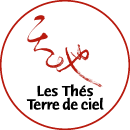
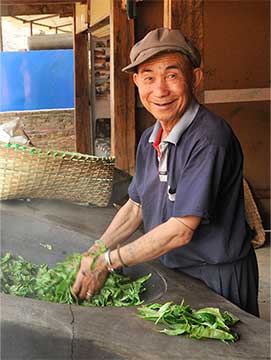
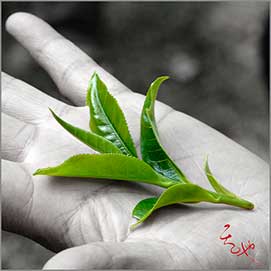
What is Pu'Erh tea?
Pu'Erh is a great Chinese tea from a very old tradition and a powerful health tea.
It is harvested from a particular variety of tea trees growing in natural gardens, in the mountains of Yunnan (South West China). These trees can be very old and even wild.
It is known for its energetic properties and its benefits, in Asia as in Western Countries.
See:About the benefits of our teas - part 1
About the benefits of our teas - part 2
There are two types of Pu'Erh teas: "Sheng Cha" (green or raw Pu'Erh) and "Shu Cha" (fermented Pu'Erh (also called red, ripe or dark Pu'Erh).
The raw Pu'Erh has the particularity of maturing over the years, like wine, due to a process called "natural post fermentation".
The ripe Pu'Erh also improves with time.
Pu'Erh is the name of a small town in Yunnan, a large tea market. Since the Tang dynasty (7th century), it was the meeting point of caravans carying tea to Tibet and imperial cities, on the "Cha Ma Gu Dao" (Ancient Tea and Horse Road).
There are 3 criteria conditioning the branding of “Pu'Erh” tea.
-
The leaves must come from the broad-leaf varietal of tea trees (Camelia Sinensis var. Assamica mainly).
These trees are classified into three categories: the "very old trees" (Gu Shu) some of which are several hundred years old, the "large trees" (Da Shu) and the younger "hill trees" (Qiao mu). See: https://www.the-puerh.com/fr/actu/venerables-theiers-100.html
-
The production area must be located in Yunnan in the Mekong basin (Xishuangbanna, Six Mountains, Lincang, Simao-Pu'Erh...)
-
Tea leaves must be dried in the sun (not in the oven).
In recent years, the border countries (Thailand, Laos, Vietnam) developed Pu'Erh teas according to the same principles.
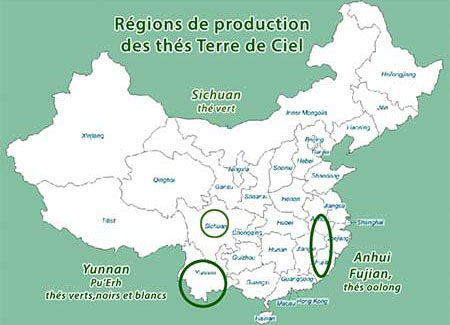
How to choose a Pu'Erh tea ?
The choice of a Pu'Erh comprises of three main factors:
-
The mountain (or village) of origin : each area having its own specific taste due to soil, altitude, exposure, the position in relation to the Mekong River and local uses.
-
The age of the trees.
-
The age of the tea and its evolution which will confer raw or mature flavours to it.
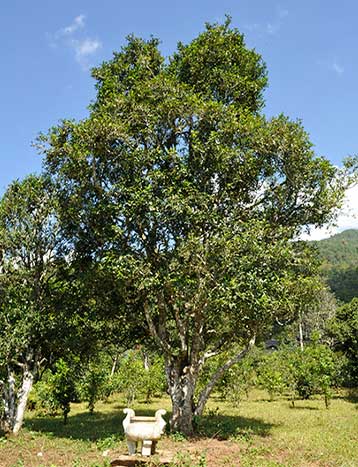

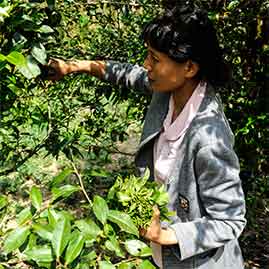
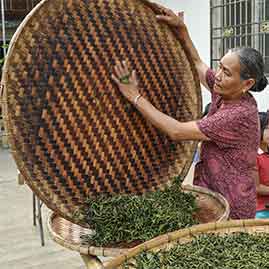
From leaf to Mao Cha
The tea trees grow naturally in a preserved environment, in altitude, in small “gardens”, and far from intensive plantations. In theory, they are not chemically treated (neither fertilizer nor pesticides). The constitution of the leaves and the exposure of the trees naturally avoids most diseases. Most of the tea farmers respect these big trees that are part of their heritage, and are a testimony of their history. But sometimes, faced with the growing demand in China, the temptation to produce more is strong. We remain very vigilant : the preservation of the tea trees and their environment is a major criterion for our choices.
.The leaves are harvested twice a year, during spring and autumn. The spring harvest is the most sought after, since the leaves are picked at the end of the dry season and may be therefore richer in flavour. But experience demonstrates that one can also find very good autumn teas. The best harvests consist of a bud and a leaf, or a bud and two leaves, very rarely a bud on its own.
Once picked, the leaves are spread out for a few hours in the shade or the sun. They begin to wilt. Then they are briefly heated in a wok, over a gentle wood-burning fire This process, called “ killing the green” or “Sha Qing” in Chinese, halts the oxidization in the leaves and partly removes some humidity. Then they are hand-rolled (some farmers also use machines). This breaks up the cell walls and kick-starts post-fermentation.
They are then put in the sun to dry. This stage is particularly important as it maintains intact all the intrinsic qualities and starts off natural post-fermentation. This is mainly why the government of Xishuangbanna has decided it to be one of the criteria authorizing the “Pu'Erh” denomination.
At last the tea is carefully sorted. The stems and broken leaves etc... are removed. The raw Pu'Erh tea, then called “Mao Cha”, is ready to be pressed or again put to mature as loose leaves.
To produce Ripe Pu'Erh, Mao Cha is piled safe from the air, in a naturally moist environment. The fermentation starts quickly and lasts about 45 days. Finally the leaves are dried and sorted again.
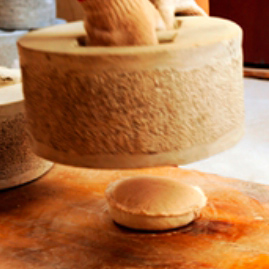
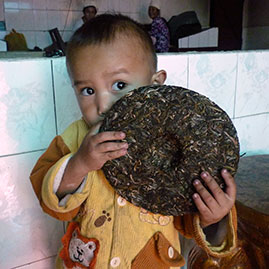
From Mao Cha to tea cake
Where does the tradition of compressing Pu'Erh tea originate from ?
In the past, Pu'Erh tea travelled extensively from Yunnan to Tibet with the caravans of the “Ancient Tea Horse Road” (Cha Ma Gu Dao). It was exchanged especially for salt and Tibetan horses. Compressing the tea enabled it to be transported in better conditions and to be kept longer.
The different stages of cake manufacturing
The Mao Cha is first weighed: each cake, in its traditional form, must weigh exactly 357g - or even 400g in some areas (For ex. The Six Mountains). Then the tea is placed in a cylindrical container of which the bottom is pierced with small holes, and passed through gentle steam for a few seconds. This process humidifies and softens the leaves and the Mao Cha stacks itself.
The tea is then put into a cloth sleeve and shaped into a thick cake. Then it is placed under a stone to be compacted.
The cake is then removed from the sleeve and placed in a slightly heated drying room for 2 to 3 days. This process can also be done in the sun or in the shade of a ventilated place depending on climatic conditions. This step can take up to several days. Once dry, the cakes are wrapped in paper and dated. They are then stacked by seven in a bamboo leaf casing binded together with ties (also made of bamboo). These are called “tongs”. Finally these “tongs” are grouped by dozen in bamboo woven baskets.
The cakes can then begin their slow ripening and mellowing.
To see the making of the Pu'Erh cakes (here our Six Mountains Tea) please follow the link :
http://www.youtube.com/watch?v=B3zvikxkK20
